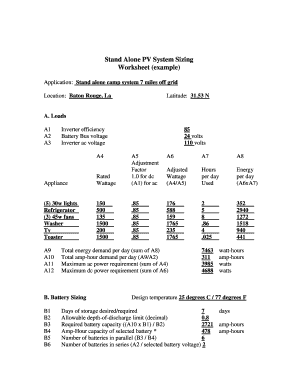
Get Stand Alone System Sizing Procedure W-charts And Blank.doc - Dnr Louisiana
How it works
-
Open form follow the instructions
-
Easily sign the form with your finger
-
Send filled & signed form or save
How to fill out the Stand Alone System Sizing Procedure W-charts And Blank.doc - Dnr Louisiana online
Completing the Stand Alone System Sizing Procedure W-charts And Blank.doc is a crucial step in designing an effective solar energy system. This guide provides a clear and structured approach to help you fill out the form online, ensuring that all necessary information is accurately recorded.
Follow the steps to effectively complete the sizing procedure.
- Click ‘Get Form’ button to access the form and open it in the editor.
- Begin by filling in the application and location fields in the header section. Specify the application type, for instance, a stand-alone camp system, and include your exact location details.
- Proceed to section A, which focuses on loads. Input the inverter efficiency, battery bus voltage, and inverter AC voltage in the appropriate fields, ensuring accurate figures from your system specs.
- List all appliances that your system will power, along with their rated wattage under column A4. Adjust the wattage values using the adjustment factor listed in column A5 for both AC and DC loads.
- Calculate the adjusted wattage by dividing the rated wattage by the adjustment factor in column A6. Document the hours of usage per day in column A7, followed by calculating the energy consumed per day for each appliance in column A8.
- In columns A9 to A12, summarize the total energy demand per day, total amp-hour demand, maximum AC power requirement, and maximum DC power requirement. Ensure all calculations are based on your previously filled data.
- Move to section B for battery sizing. Fill in the days of storage required, allowable depth-of-discharge limit, and calculate the required battery capacity based on your energy needs as discussed in the previous sections.
- Record details about the selected battery's amp-hour capacity and determine the number of batteries needed in parallel and series to meet your system's requirements.
- In section C, focus on PV array sizing. Set the design tilt, total energy demand per day, and battery round trip efficiency in the respective fields. Use module specifications to complete calculations for required array output, module output, and number of modules needed.
- Lastly, review the Balance-of-System (BOS) requirements, ensuring all necessary components for safety and efficiency, such as voltage regulators and fuses, are considered.
- Once all sections are filled out, save your changes. You can download, print, or share the completed form as needed.
Complete your stand-alone system sizing procedure online today to ensure a well-designed solar energy system.
Designing a standalone PV system involves several key steps. First, assess your energy needs, then choose the right components: solar panels, inverter, and battery storage. After that, layout the physical design and orientation of the system for optimal sun exposure. The Stand Alone System Sizing Procedure W-charts And Blank.doc - Dnr Louisiana is an invaluable resource for confirming each step and ensuring a robust design.
Industry-leading security and compliance
-
In businnes since 199725+ years providing professional legal documents.
-
Accredited businessGuarantees that a business meets BBB accreditation standards in the US and Canada.
-
Secured by BraintreeValidated Level 1 PCI DSS compliant payment gateway that accepts most major credit and debit card brands from across the globe.


